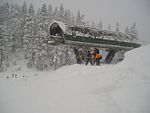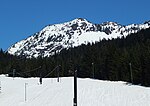Snoqualmie Pass

Snoqualmie Pass is a mountain pass that carries Interstate 90 (I-90) through the Cascade Range in the U.S. state of Washington. The pass summit is at an elevation of 3,015 feet (919 m), on the county line between Kittitas County and King County.Snoqualmie Pass has the lowest elevation of the three east–west mountain routes across Washington State that are kept open year-round, along with Stevens Pass (US 2) to the north, and White Pass (US 12) to the south. I-90 is the primary commercial artery between Seattle and points east, carrying an average of 29,000 vehicles through the pass per day. I-90 is the only divided highway crossing east–west through the state.The pass lends its name to a census-designated place (CDP) located at the summit (Snoqualmie Pass, Washington). Both the CDP and Snoqualmie Pass are named after the Snoqualmie people of the valley to the west.
Excerpt from the Wikipedia article Snoqualmie Pass (License: CC BY-SA 3.0, Authors, Images).Snoqualmie Pass
WA 906,
Geographical coordinates (GPS) Address Nearby Places Show on map
Geographical coordinates (GPS)
| Latitude | Longitude |
|---|---|
| N 47.423 ° | E -121.411 ° |
Address
Summit House
WA 906
98068
Washington, United States
Open on Google Maps










